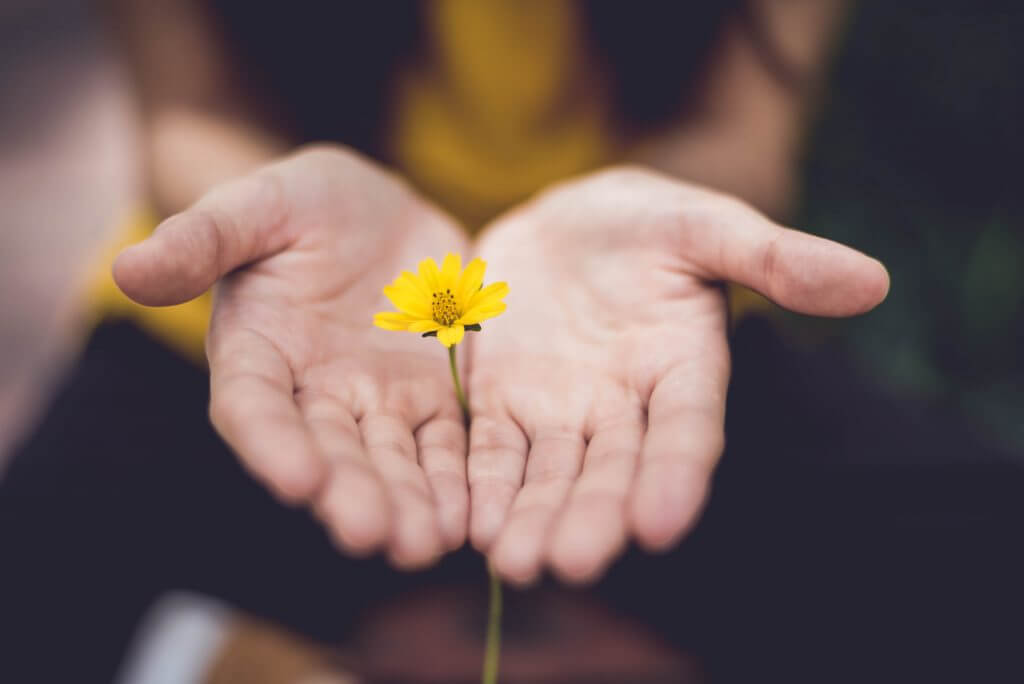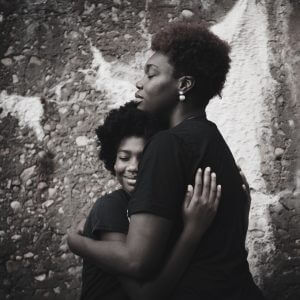
During the holiday season, invitations to practice generosity are plentiful. Bell ringers outside of supermarkets, food bank fundraisers at the office, and blanket and toy drives for the houseless remind us of the many ways we can open our hearts through the act of giving. They also offer us a moment to reflect on the practice of generosity. Is the act of giving the same as practicing generosity? And do they make the same impact on our inner experiences?
In this article, we’ll explore the different ways we can define and think about generosity, and try some mindful activities for cultivating generosity–in our own lives and with youth. We’ll also find out what scientists are learning about the links between generosity and our health and well-being.
What is Generosity?

The University of Notre Dame’s Science of Generosity Project defines generosity as “the virtue of giving good things to others freely and abundantly.” When we think deeply about this definition, three parts stand out clearly. Generosity is giving “good things”, giving “freely”, and giving “abundantly.”
We can deepen our experience of generosity by moving from acts of generosity to cultivating an attitude of generosity. When we embody an attitude of generosity, the good things we share expand out from deep within our hearts as an offering of freedom from fear–no one need fear that I will harm them, no one need fear that I will take from them what is not mine, no one need fear that I will cause harm with my words. To show up in the world, especially when working with youth, as love and safety, is generous beyond measure.
Educators, Explore Mindfulness in our 101 Course
In 101: Mindfulness Foundations, learn practices that can resource you during the school day and daily life, with trauma-sensitive approaches for navigating emotons, working with thoughts and biases, and cultivating compassion and joy. Educators earn credits.
Giving Good Things
When we practice generosity, the “good things” that we give can take many forms. Certainly, some “things” are tangible items like toys, blankets, and food. Giving material things to help others is both a valuable and needed act of generosity. We can also give things like our time, our talents, and our full presence when we are with the youth we serve. A quick and important caution with giving things: in my years of service in Title 1 schools, and economically marginalized communities, I have come to know that it is critical that we remember to give with respect and humility, acknowledging ourselves as equals in the giver-receiver relationship.
Giving Freely
How we give is as important as what we give.
It’s said that there are two kinds of giving; one-handed giving and open-handed giving. One-handed giving is when we offer something a bit unwillingly. I once had a fellow teacher comment on a book he saw displayed on a shelf in my classroom. He mentioned how fondly he remembered his mother reading the book to him as a child. I had purchased the book as a brand new teacher and it had been a beloved part of my collection for many years. I didn’t want to part with it, but I offered it anyway. My friend was so grateful and I was happy for him as I watched him flip through the pages. But, as I watched him walk away with the book, I had a yearning in my heart, a subtle feeling of loss. I had given the book away with just one hand.
Contrary to one-handed giving, open-handed, or open-hearted generosity is a way of letting go with kindness and gentleness that has no regret, no feeling of loss associated with it. Open-hearted generosity is a boundless generosity that expands and lightens the heart because it is rooted deeply in the concept that we are one, there is no separation between us. I have a dear friend who is both kind and gentle. She is that kind of person who is easy to love and be around. She once complimented me on a pair of earrings I had just purchased that day and that I couldn’t wait to wear. Yet, the moment she smiled at them, I knew that they belonged to her. Without even really thinking, I took them off and gave them to her. It was a fluid kind of gesture, it just happened without thought, judgement, or hesitation. When she put the earrings on, they looked stunning and the felt sensation that followed was an opening and lightening of the space between my collar bone and lower ribs. When we practice generosity in an open-handed way, there is no reluctance, only a forward movement toward the authentic way of the heart.
Giving Abundantly
Giving abundantly invites us to draw deeply upon knowing that our lives are plentiful. Within each of us, there is an unlimited supply of love and compassion. It is from this abundant heart space that generosity flows from.
Consider this story told by Thich Nhat Hahn:
There is a kind of vegetable in Vietnam called he (pronounced “hey”). It belongs to the onion family and looks like a scallion, and it is very good in soup. The more you cut the he plants at the base, the more they grow. If you don’t cut them they won’t grow very much. But if you cut them often, right at the base of the stalk, they grow bigger and bigger. This is also true of the practice of generosity. If you give and continue to give, you become richer and richer all the time, richer in terms of happiness and well-being. This may seem strange but it is always true.
Mindfulness Practices to Cultivate Generosity
Cultivating Generosity with Youth
Act in Service. Invite youth you work with to research the needs in their communities and organize a service project around this need. Schools and youth organizations always need extra hands. Whether it’s painting a mural, cleaning up trash, or reading to younger children. The benefit of practicing this kind of generosity locally, is that youth will be able to witness the effects of their giving. Be sure to dedicate time to reflecting on how the act of generosity made the kids feel.
- Smile. Giving away a smile can be a simple yet impactful form of generosity. Invite students to identify a person at school whom they will offer a smile to at least once a day for month. Students can reflect on this process by journaling how if feels each day to give in this way.
- Practice Self-Love. Being generous with ourselves can be a lifelong challenge. We can support our youth with developing healthy self images by encouraging them to practice self-love. Give each student a small hand held mirror. Invite them to look deeply at themselves and to then say nice things to themselves. Be sure to invite students to reflect in how it felt to be generous toward themselves. Do this often! And don’t forget to practice with them!
A Guided Generosity Practice for You
Sit in a position that feels stable yet comfortable.
If it feels right for you, close your eyes. If it feels better to keep you eyes open, gently gaze down in front of you.
Settling into this moment by noticing your breath.
Now, I’d like to invite you to bring to mind a time when someone was generous toward you, a time when someone did something nice for you. Bring that time to mind in full color, reflecting on who was there, where you were…How did it make you feel? Where does that feeling live in your body? Really feel into what this time was like for you.
If your mind begins to wander, that’s okay. Gently escort your attention back to feeling the time when someone did something nice for you.
Now, I’d like to invite you to bring to mind a time when you were generous with someone, a time when you did something nice for someone else. Again, really sinking into this memory by recalling who was there, where you were, and what was happening. How did it make you feel to be generous in this way? Where do you feel that in your body? What are the sensations of generosity like in your body?
Ending this short contemplation by resting back in your breath for a moment.
The Benefits of Generosity
The scientific consequences of generosity have been studied for many years now. On an individual level, the Greater Good Science Center White Paper on Generosity shows the benefits of practicing generosity to be far reaching. Scientists are discovering generosity to be an ally to our health–from positive effects on mortality to physical and emotional wellness. On a relational level, generosity can be like connective tissue, connecting us with others through honest, loving engagement. Our communities thrive when we give freely and abundantly.
Additional Resources: Children’s Books with the Theme of Generosity
- The Giving Tree- Shel Silverstein
- The Rainbow Fish- Marcus Pfister
- The Giving Book- Eileen Saben
- Should I Share my Ice Cream- Mo Willems
- Under the Lemon Moon- Edith Hope Fine
- Mama Paya’s Pancakes- May and Rich Chamberlain
- Those Shoes- Maribeth Boelts
Love is the ultimate gift of ourselves to others. When we stop giving we stop loving, when we stop loving we stop growing, and unless we grow we will never attain personal fulfillment. – Mother Theresa

Amy Love has been an urban public school educator for over 25 years. During this time she has been a classroom teacher, intervention specialist, peer coach, professional development specialist, and curriculum writer. In addition to teaching and practicing mindfulness with students, teachers, and administrators in schools, Amy has taught mindfulness in a variety of other settings, such as prisons, community outreach programs, and yoga communities. She is a graduate of the Mindful Teacher Certification Program (2016) and is also on staff with Mindful Schools as a guiding teacher. Amy is also a graduate of Against the Stream’s Community Meditation Facilitator program. She currently facilitates for Meditation Coalition’s People of Color Sangha as well as offering mindfulness programing through Insight LA. Amy is particularly interested in bringing mindfulness practices to communities who have been impacted by historical racial trauma and well as those experiencing suffering related to issues of poverty and migration.


 Act in Service.
Act in Service.